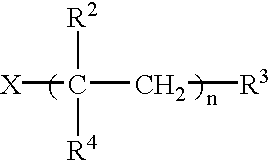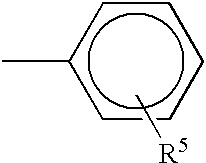Matrix for transdermal drug delivery
a technology of matrix and drug, applied in the field of matrix for transdermal drug delivery, can solve the problems of limited range of copolymers suitable for use as matrix, substantial barrier on the skin, etc., and achieve the effect of lifting cleanly from the skin and heavy loading
- Summary
- Abstract
- Description
- Claims
- Application Information
AI Technical Summary
Benefits of technology
Problems solved by technology
Method used
Image
Examples
example 1
[0078]Copolymer (50 g of 54 / 36 / 10 IOA / HEA / PSMac, 41% solids in 95 / 5 ethyl acetate / isopropanol, inherent viscosity (“iv”)=0.75 dl / g) and isopropyl myristate (1.08 g) were combined in a glass jar. The jar was capped and placed on a roller for about 24 hours. The resulting formulation was knife coated at a wet thickness of 12 mil (305 μM) onto a silicone release liner [5 mil (127 μM) Daubert PESTER]. The coated release liner was oven dried at 110° F. (43° C.) for 4 minutes then at 180° F. (82° C.) for 4 minutes. The resulting coating contained 95 percent 54 / 36 / 10 IOA / HEA / PSMac copolymer and 5 percent isopropyl myristate. The coated liner was laminated to the corona treated side of a 3 mil (76 μM) polyethylene film. The compliance was measured using the test method described above and found to be 0.42×10−5 cm2 / dyne (average of three independent determinations).
examples 2-33
[0079]Using the general method of Example 1, a series of coated sheet materials in which the copolymer, softener and amount of softener were varied was prepared. The copolymer, identity and amount of softener, wet coating thickness, and the compliance values are shown in Table 1. Unless otherwise indicated, each J-value is the average of three independent determinations. When the compliance was “not run”, the formulation was too soft to be tested.
[0080]
TABLE 1CopolymerWet CoatingJ-valueExampleivThickness(× 10−5NumberType(dl / g)Softener(mil / μM)cm2 / dyne)254 / 36 / 10 IOA / HEA / PSMac0.7510% IPM12 / 3050.57354 / 36 / 10 IOA / HEA / PSMac0.7513% IPM12 / 3050.57454 / 36 / 10 IOA / HEA / PSMac0.7517% IPM10 / 2540.80554 / 36 / 10 IOA / HEA / PSMac0.7520% IPM10 / 2541.12654 / 36 / 10 IOA / HEA / PSMac0.7525% IPM 8 / 2032.26754 / 36 / 10 IOA / HEA / PSMac0.29 5% IPM12 / 3051.09854 / 36 / 10 IOA / HEA / PSMac0.2910% IPM12 / 3051.65954 / 36 / 10 IOA / HEA / PSMac0.2913% IPM12 / 3051.831054 / 36 / 10 IOA / HEA / PSMac0.2917% IPM10 / 2542.1311154 / 36 / 10 IOA / HEA / PSMac0.2920% IPM10 / 2543...
examples 34-38
[0081]Using the general method of Example 1, a series of coated sheet materials in which the copolymer was varied but the amount of IPM was theoretically held constant was prepared. The copolymer and amount (both calculated and determined using a modification of the method described above) of IPM, wet coating thickness, and the compliance values are shown in Table 2. In the modified analysis procedure, sample preparation involved combining 2 mL ethyl acetate containing 0.05 mg / mL lauryl acrylate with 25 mg of polymer. In the modified analysis procedure, isopropyl myristate standards did not contain copolymer. Unless otherwise indicated, each J-value is the average of three independent determinations.
[0082]
TABLE 2CopolymerWet CoatingJ-valueExampleivWt Percent IPMThickness(× 10−5NumberType(dl / g)Calc.Actual(mil / μM)cm2 / dyne)3478 / 14 / 8 IOA / HEA / PSMac1.6012013.510 / 2541.6823578 / 14 / 8 IOA / HEA / PSMac1.0712011.710 / 2543.863695 / 5 IOA / PSMac0.472012.510 / 25412.83755 / 40 / 5 IOA / HEA / PSMac0.382013.410 / 2541...
PUM
| Property | Measurement | Unit |
|---|---|---|
| Tg | aaaaa | aaaaa |
| glass transition temperature | aaaaa | aaaaa |
| surface area | aaaaa | aaaaa |
Abstract
Description
Claims
Application Information
 Login to View More
Login to View More - R&D
- Intellectual Property
- Life Sciences
- Materials
- Tech Scout
- Unparalleled Data Quality
- Higher Quality Content
- 60% Fewer Hallucinations
Browse by: Latest US Patents, China's latest patents, Technical Efficacy Thesaurus, Application Domain, Technology Topic, Popular Technical Reports.
© 2025 PatSnap. All rights reserved.Legal|Privacy policy|Modern Slavery Act Transparency Statement|Sitemap|About US| Contact US: help@patsnap.com



